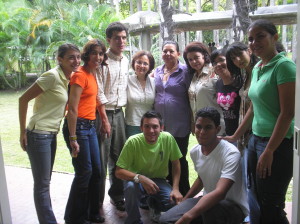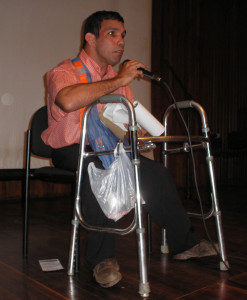
Grammar: Essential for Reading Development and Comprehension – Miguel Mendoza
“Although a more precise role for syntactic abilities, free of other factors, remains to be worked out, its role [in reading comprehension] may be genuine” (Perfetti, C., Landi, N. & Oakhill, J., 2005:238).
I have always wondered why some colleagues cringe at the sound of the word “grammar”. I know it sort of became the Ugly Duck of anything related to language learning after the now infamous grammar-translation method. Some would even say learners will “naturally” pick up anything related to grammar just by listening and reading. Are they? Which learners are we talking about? Children? Teenagers? Adults? As an English for Academic Purposes (EAP) teacher, my main interest is reading and, fortunately, there’s been a lot of research supporting the essential role of grammar in reading development and comprehension (Nation & Snowling,2000, Grabe, 2009, Perfetti, Landi, & Oakhill, 2005 among others). Briefly, but not overlooked, Richard Day (2013) refers to grammar as a part of the reading developmental process as well.

Now why grammar is an essential aspect in reading development? Grabe (2009), the main researcher I will refer to all along this post, talks about “syntactic parsing” in reading. This is part of a group of lower level skills (eg. word recognition, meaning encoding) necessary for reading fluency. Also, he says, for beginner readers, syntactic processing can help them understand paragraphs, news, articles since it is a sort of “glue that holds together sentences and texts specifies how the content is to be understood”. As I wrote before, I teach EAP and our courses are offered during the first four semesters of the career (freshman courses). That is, our students are beginner readers and also some of them have got serious low linguistic levels (below A1!). Very few students are independent or proficient users of english.
Now, according to Grabe (2009), syntactic parsing involves:
|
Subconscious analysis |
Cueing systems |
Word ordering |
Tacit knowledge |
| Without us knowing we are using grammar knowledge to understand sentences. Some sort of intuitive, subconscious voice tells us there’s something wrong or missing in a sentence. | Tenses, articles, prepositions, quantifiers, modal verbs are as important as NOUNS and VERBS to understand sentences. | The author is conveying different meaning depending on how he / she arranges sentences. | The reader sometimes has got to infer using his/her grammar knowledge to guess what the author means |
| The reader sort of intuitively feels that “Broke antique washing night the all the man will vase dishes who” does not sound right. | It is easier to understand more from a sentence like: “The man fired from the rifle factory screamed at his boss” than “Man fired rifle screamed boss”. | A good example is:
“Tom chewed on the dog’s leg.” “The dog chewed on Tom’s leg.” |
A sentence like “The man lent the money to gamble lost it all” may take some time to process so the reader may need to use grammar to infer its meaning. |
Note: all sentence examples are taken from Grabe, 2009.
Taking all this into account, our EAP reading courses has got an explicit grammar component in each of our lessons at least until English 2. We teach four (4) EAP courses during the first-semester courses. By the explicit teaching of grammar I mean: identifying and practicing grammar points before students get to the reading text (verb, nouns, adjectives, articles, adverbs, conjunctions). All grammar points are introduced and practiced through a consciousness-raising approach (Thornbury, 2006). That is, students guess the rules from language data. In English 3 and 4, we focus on any grammar aspects emerging from the text. In our courses, grammar is part of the syllabus. It is worth pointing out it is not a course in itself. We transition from identifying grammar points separate from the text (English 1 and 2) to grammar being noticed in the texts themselves (English 3 and 4). Also, we start in English 3 our extensive reading program to expose them to basic grammar aspects (review) and more advanced complex structures.
If I had to represent how we go about with grammar in our EAP courses, it will be like this:


Furthermore, teaching grammar in our EAP courses also helps facilitate the introduction and practice of reading strategies: identifying topic, main idea, reference and nominal groups. It also helps participants know when a writer is making contrasts, describing routine, describing facts, narrating. It also helps participants know where the most meaningful parts of a sentence are (nouns -heads of nominal groups- and main verbs).
As an EAP teacher, we know grammar is one of many aspects we have to take into account to help our students understand a text written in English. We also know syntactic parsing is one of several lover level skills needed for reading fluently and together with higher level skills to explain how reading works.
According to Grabe (2009), we can sum up the implications of teaching grammar in reading as follows:
- Textual information is expressed through grammatical information, so grammar especially for beginning readers is necessary.
- Grammar should be seen as a discourse signaling system guiding the reader to identify cues that will help him/her understand a text.
- It is advisable to focus on salient grammar aspects emerging from the text. Advanced or complex grammar can be learnt from reading exposure (extensive reading)
As a novice EAP teacher, for some time, I was afraid to say I was teaching grammar in my courses. But experience and research reading have taught me otherwise. Grammar for my Venezuelan EAP students (South of America) is one of the linguistic aspects we do consider to help them in their reading developmental process. We are currently updating the content and activities of our course to provide our students with new learning experiences. Grammar will remain as a much needed aspect to guarantee they will become confident readers in the academic and professional world.
References:
Day, R. (2013). Teaching reading. English language teacher development series. TESOL International Association
Banville, S. (2013). Mount Fuji to be World Heritage site. Retrieved from: http://www.breakingnewsenglish.com/1305/130504-mount_fuji.html
Grabe, W. (2009). Reading in a Second language. Moving from theory to practice. New York: Cambridge University Press.
Thornbury, S. (2006). An A-Z to ELT. A dictionary of terms and concepts. Macmillan
Perfetti, C., Landi, N. & Oakhill, J. (2005). The acquisition of reading comprehension skills. In M. Snowling & C. Hulme (Eds.), The science of reading (p.227-47). Malden, MA: Blackwell.
Nation, K., & Snowling, M. (2000). Factors influencing syntactic awareness skills in normal readers and poor comprehenders. Applied Psycholinguistics 21, 229-41
Image and charts:
Miguel Mendoza by Miguel Mendoza is licensed under a Creative Commons Attribution-NonCommercial-NoDerivs 3.0 Unported License
Connect with Ann, Adam, Alexandra, Arzu, Rose, Miguel, and other iTDi Associates, Mentors, and Faculty by joining iTDi Community. Sign Up For A Free iTDi Account to create your profile and get immediate access to our social forums and trial lessons from our English For Teachers and Teacher Development courses.




